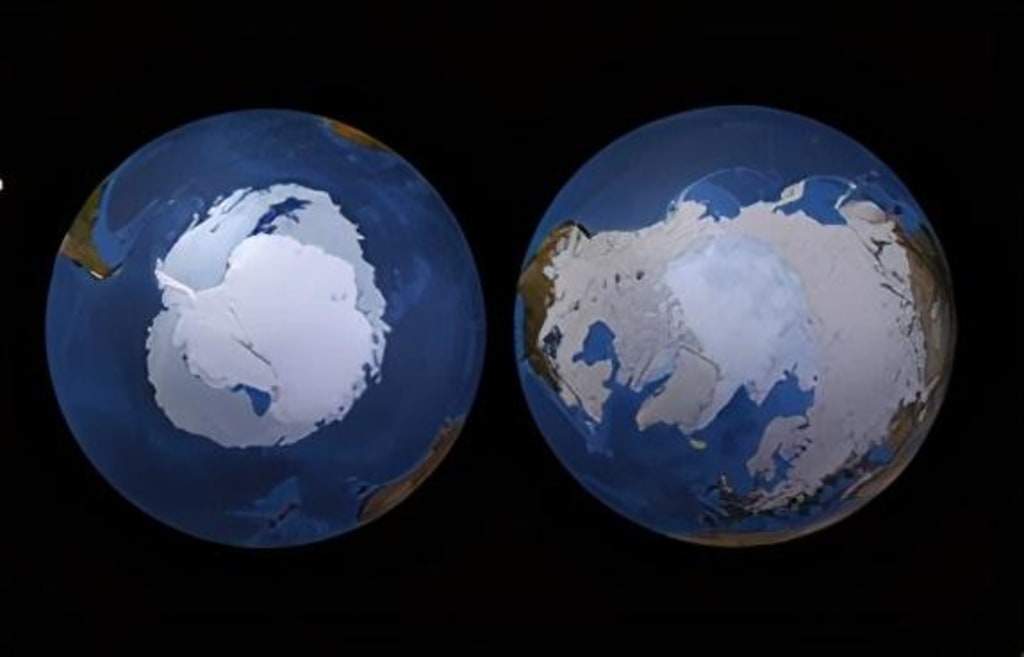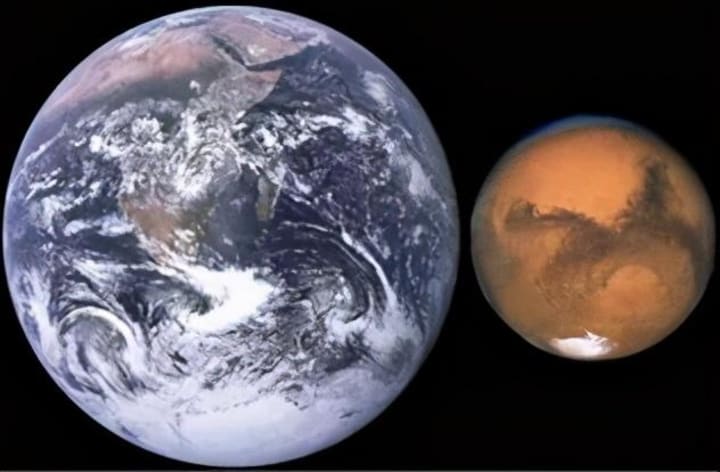Are the poles of Mars also icy worlds?
Mars wears a mysterious white hat

When it comes to the Earth's South Pole and the North Pole, everyone's mind will immediately conjure up images of icy skies and snow-capped mountains. So, the Earth's neighbors - Mars, that is, Iron Man Musk said to immigrate to the planet, its north and south poles, and how it is? Will also be the magnificent appearance of snow and ice?
First look at the poles of Mars
At the end of the 17th century, the Dutch astronomer Huygens used a sophisticated telescope of his design to discover for the first time that both the north and south poles of Mars have a huge "white spot" as if wearing a white hat. Although we do not know what kind of sight this astronomer saw at that time, later, through human efforts, we were able to take an "ID photo" of the Red Planet wearing a white hat.
A comparison found that the Earth and Mars are wearing white hats. Hats, in ancient times, were also called "crowns". We Chinese have given the "hats" at the poles of Mars an elegant name - "polar crown", while the Western English is "Martian polar ice cap".
A closer look at the polar caps of Mars
We can see that the north and south poles of Mars are covered by a thick white material, which contrasts with the red-brown areas, and we can also observe the traces of strong winds and storms. Such a scene reminds us of the icy conditions at the north and south poles of Earth. Sometimes, white clouds also appear on Mars, obscuring the geological features of the Martian surface and preventing human Mars orbiting probes from taking clear pictures.
Mysterious white material
What is this white substance that looks like a hat or a latte? In the late 18th century, the British scientist Stoney envisioned the white substance to be solid carbon dioxide, commonly known as "dry ice". By the middle of the 20th century, astronomer Koeppel, using spectroscopic observations, hypothesized that the white matter was water ice rather than dry ice. Due to the limitations of science and technology at the time, Stoney and Koeppel could only speculate.
It was only after several explorations of Mars by man-made probes that humans officially confirmed that the polar caps contained 85% carbon dioxide dry ice and about 15% water ice. This is a huge advance in the understanding of Mars and an evidential response to the scientific hypothesis of our ancestors.
The polar cap contains water ice and carbon dioxide dry ice and the Martian polar cap changes with the seasons
Photographs from the Mars rover show a dry, barren world of sand and dust over much of the surface, so how do the polar caps form?

According to the experience of life on Earth, the first feeling of seeing the snowy, icy frozen world is of course "cold". Mars, the "sister planet" of the Earth, also has a winter and summer cycle, just like the Earth. Mars is farther away from the Sun than the Earth, and the average surface temperature is lower than that of the Earth, with an average temperature of about -60°C. The temperature at the poles is even lower, which makes the material consisting mainly of water ice and dry ice at the poles of Mars permanent.
Does the Martian polar cap change with the seasons? More than 20 years ago, humans have used the Hubble Telescope to observe changes in the polar caps of Mars. The polar cap of the North Pole evaporates about 1 meter of dry ice each year during the Martian summer, while the dry ice at the south pole of Mars is about 8 meters thick and does not evaporate in time for the entire summer. This causes the Martian polar cap to change from year to year, similar to the changes in ice and snow at the Earth's north and south poles. When the temperature is high in summer, the ice melts and the polar cap shrinks, while in winter, as the temperature drops, the atmospheric carbon dioxide begins to condense and the polar cap becomes larger. Water and carbon dioxide travel between the polar caps and the atmosphere by sublimation and condensation, forming an important part of the present-day Martian climate.
The polar cap contains not only lakes of liquid water but also crater ice lakes
Whether water ice or dry ice, is the polar cap only solid "ice"? As early as 2018, Italian scientist R. Orosei's team used radar data from the Mars Express orbiter to discover a 20-km-wide body of liquid water 1.5 km below the Martian south polar cap. And on September 28, 2020, with new radar data from the orbiter, Italian planetary scientist S.E. Lauro's team newly discovered three bodies of liquid water beneath the Ultimi Scopuli, the largest of which is about 20 km by 30 km long. This is the major discovery of the human Mars exploration journey - it turns out that Mars is not dry and barren as seen by the naked eye!
In addition to the subsurface layer containing liquid water, there is a well-preserved crater, Korolev, in the southern part of the Great Olympia-Onda dune field in the Martian Arctic. The bottom of the crater, located two kilometers below its rim, encloses a dome-shaped deposit about 1.8 km thick, a compound of water ice and dry ice. The air over the ice is heavier than the surrounding air when it cools, so the "ice" in the Korolev crater is permanently stable. Since air is a poor conductor of heat, the water ice layer is effectively protected from heating and sublimation.
Crater ice lake (created using digital terrain models and Mars Express exploration data)
On Earth, water is the source of life and a treasure for human survival.
On Mars, the discovery of water-ice resources is undoubtedly gratifying.
Humanity is sending Mars rovers to space, driving to Mars, looking forward to these "pioneers" digging out more "treasures" and get more discoveries!
About the Creator
Copperchaleu
The most charming woman I've ever met.
Enjoyed the story? Support the Creator.
Subscribe for free to receive all their stories in your feed. You could also pledge your support or give them a one-off tip, letting them know you appreciate their work.






Comments
There are no comments for this story
Be the first to respond and start the conversation.